THE FUTURE OF MASSACHUSETTS
A GOOD citizen will naturally ask himself whether he can be serviceable in making the future of Massachusetts, not safe for democracy, but safe for developing humanity. OLD INN - NORTH BROOKFIELD We were at the polls the other day and certainly we felt no pride in democracy. It is, indeed, the best form of government if intelligence accompanies it; otherwise is it not the very worst form of government? Somehow we must get before our people images of beauty. They must become accustomed to seeing fair outlines, because education is mostly a matter of the eye, with the average man. If we can establish regions, where no unsightliness reigns for a mile, could anything promise better for our future? There are districts where special efforts, in sanitation and health education, are being attempted, with the idea of forming model communities in these respects. But the mind of a man cannot be normal unless it can feed on something worth looking at. There are towns like Lancaster, for instance, where the tree warden is instructed to guard and foster the beauties of the roadside, and more and more that highly important action is being followed up in other towns. There is nothing as yet, however, that prevents a citizen from choosing ugliness rather than beauty in his dwelling as well as his grounds. 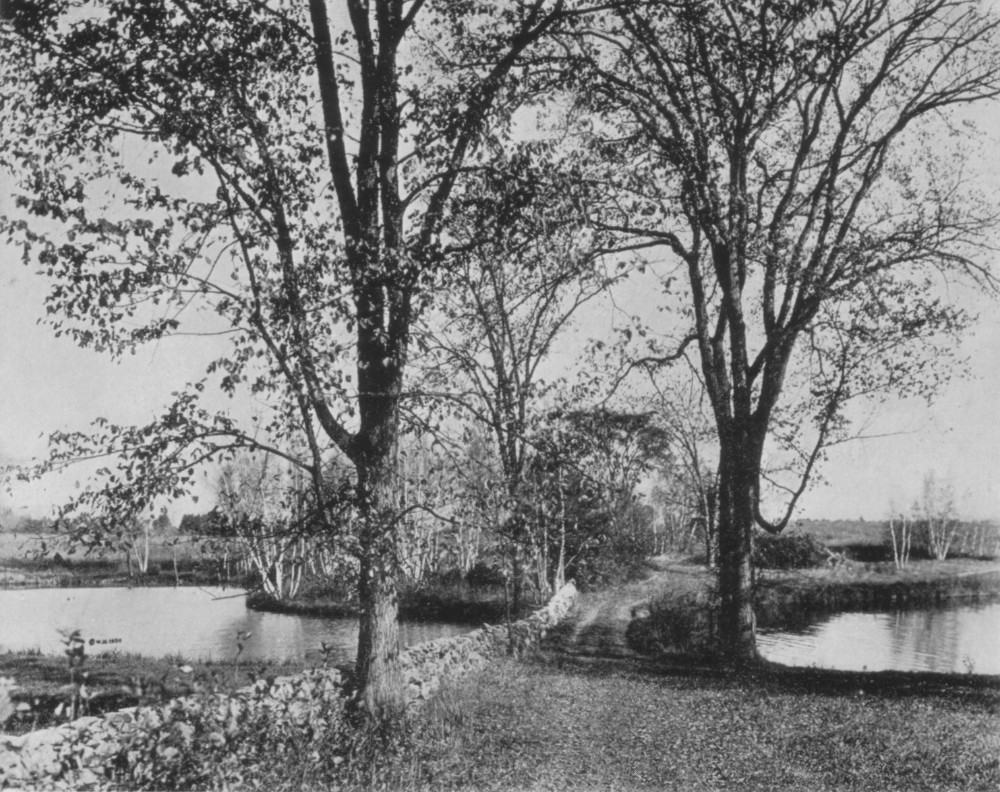 A FRAMINGHAM CAUSEWAY 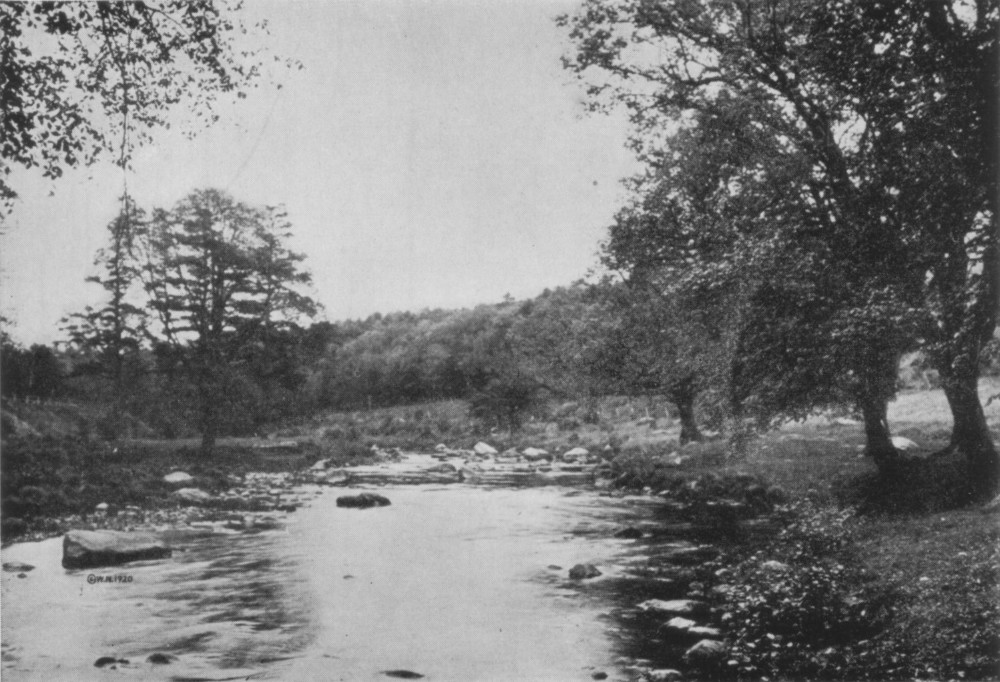 SWIFT WATER - RUTLAND - PETERSHAM 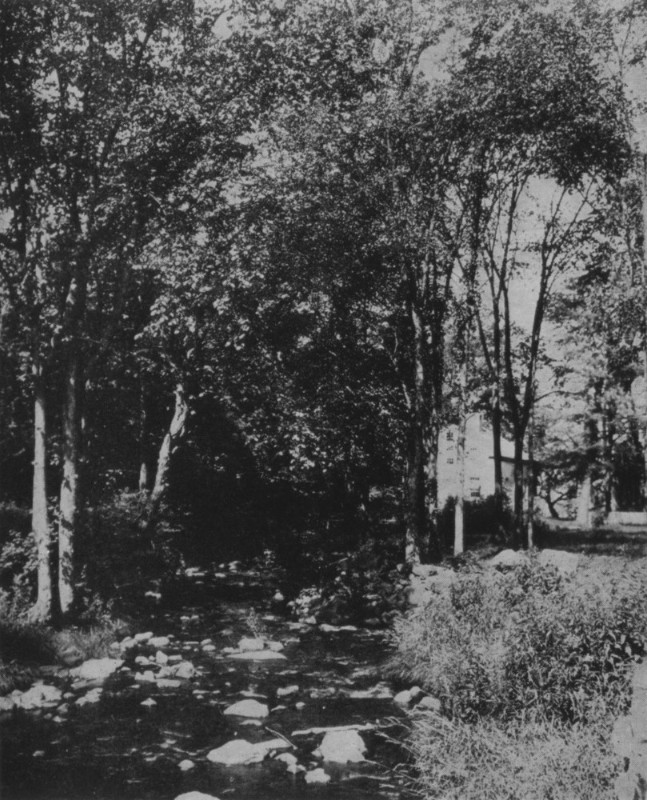 A NORFOLK BROOK 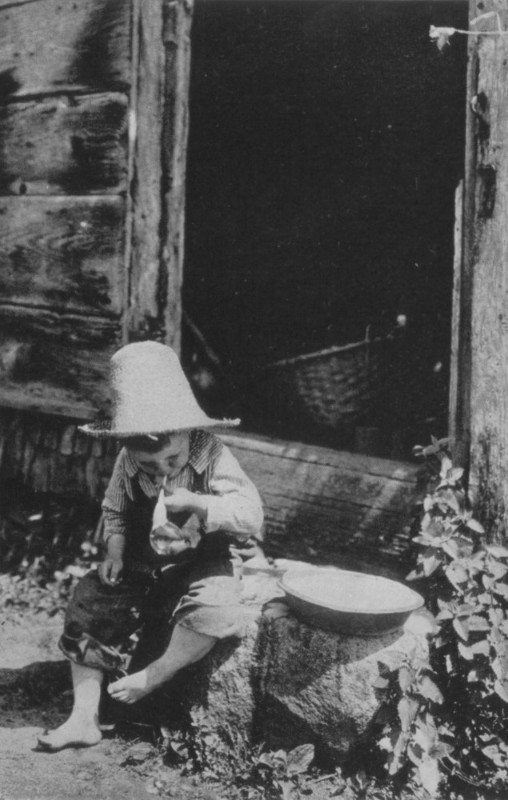 BLOWING BUBBLES - PEMBROKE People are very apt to stand on
their constitutional rights when they wish to do nothing. We remember a notably
indolent person who, when offered a job, replied tartly that the Constitution
of the United States guaranteed him the right to work or not as he pleased. Of
course, the Constitution guaranteed him no such thing, but freedom is, in the
thought of many, freedom to be indolent or to do poorly and slackly what ought
to be done well. There is no way of reaching such persons. They are
self-punished, but their punishment does not reform them, at least now.
Example, therefore, is the only teacher, and the owner of country acres who is
careful to see that his quarter mile of road is treated in an esthetic manner,
is doing for the community as much as he can, perhaps. Massachusetts has the advantage of
age. Her roads are largely constructed, as well as her established culture
features. She has traditions of decency. She has many excellent examples of
honest dealing with nature so as to bring her beauties to the fore, rather than
to mask them and kill them. There is wealth, and a long experience of good and
bad methods. There is a militant minority eager for the beautifying of the
state. Of course we shall not have a thoroughly beautiful state without understanding that even external beauty must rest on the character of the people. A sense of permanence and strength must be in the character. Otherwise how shall we avoid the shingled candle extinguishers and the gimcrack ornaments, which are placed on dwellings? Unless there is repose in a man's nature reposeful architecture will not result. A fair countryside is the consequence of sympathy with nature, so that she is led rather than thwarted and distorted. After a while we find that it is not newness and freshness that we want in our homesteads, but a blending in color, form and material, that makes them a part of the landscape in which they stand. A SCITUATE DOOR We are learning that we have done many unnecessary things; that we have dragged in material from afar which was not so good as that which lay all around us. We have adopted exotic forms, and such designs as lead one to suppose that the dwelling is temporarily set down where it is, rather than that it grew there out of the needs of the place. 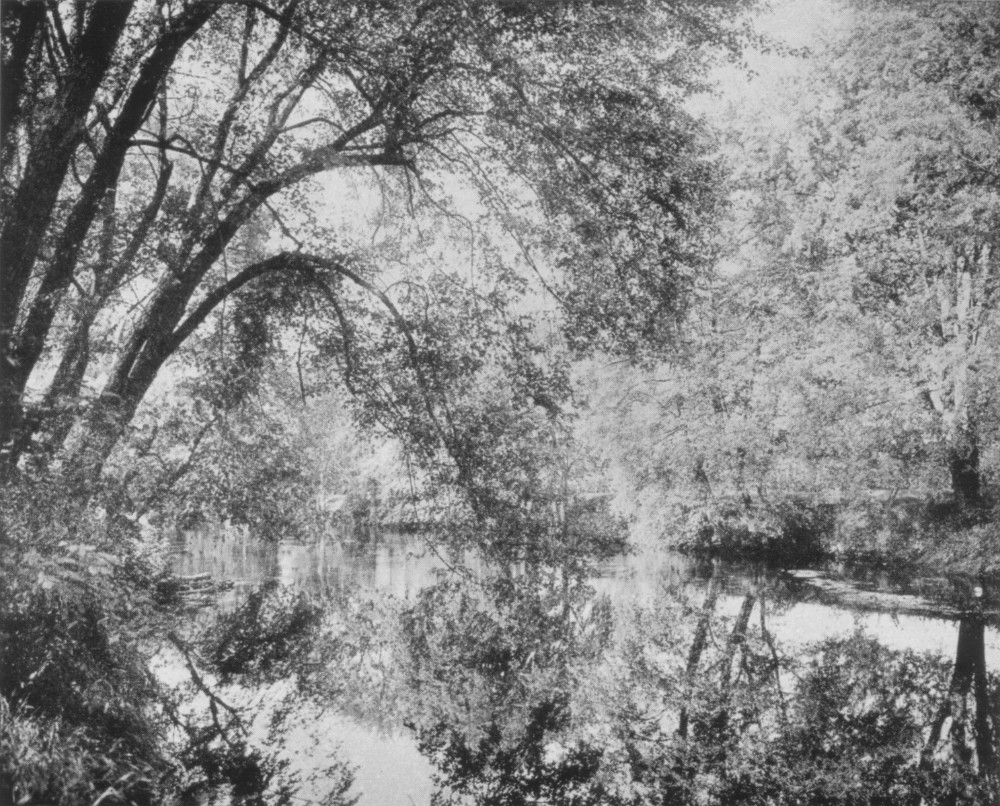 THE TRACERY OF MAY - LANCASTER  GARDENS AT PITTSFIELD 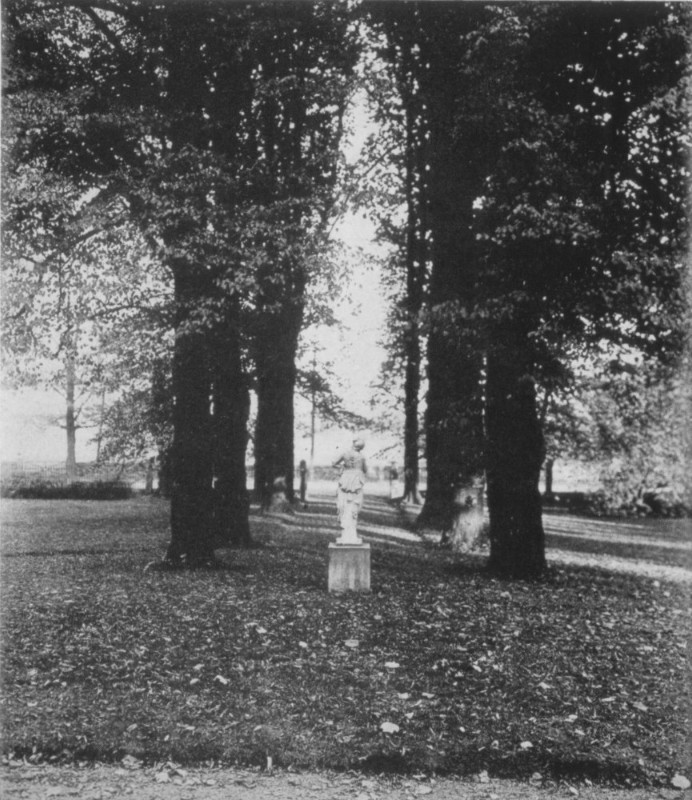 KING HOOPER HOUSE APPROACH - DANVERS 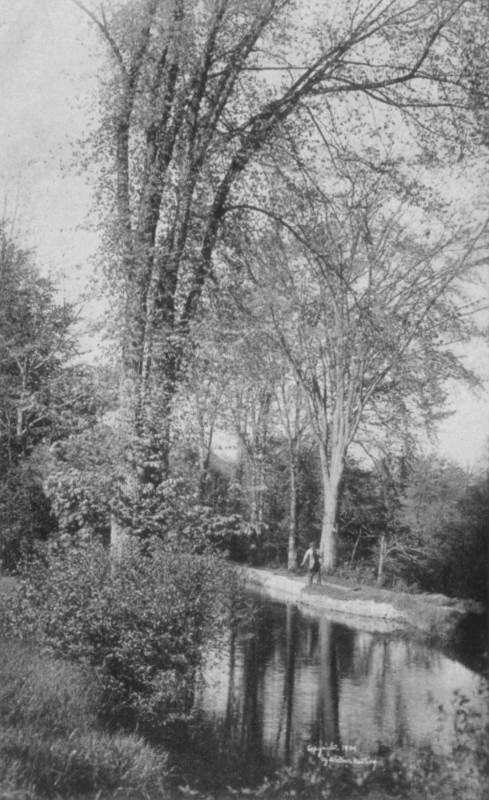 FISHERMAN'S LUCK Our farm papers and magazines are
not living up to their opportunity in setting before the country people the
restful, low, solid forms of structures. We have of late been placing classical
libraries in our New England villages. Their roofs are always pitched too low
and are bound to cause loss to the contents of the edifices together with decay
and disintegration of the buildings. We have supposed it incumbent upon us to
follow a style. One cannot say that an ancient stone farmhouse in France or
England has a style. It is better that there should be no mark that speaks
loudly of design. Strength and comfort and utility are to be satisfied first,
and not an ornament should be added for its own sake. It will be a long day before these
facts are felt by all the people. Still, they will be felt perhaps in a hundred
years, and we shall get back to a point where we were two hundred years ago. It
will be a distinct advance, for the building of that time was based upon the
needs rather than upon the uneducated pretensions of the owner. A like principle goes with landscape
features. It may be necessary, in the case of important thoroughfares, to fill
up the valleys and cut down the hills. In the case of side roads, however, and
the banks of brooks, and the contour of building sites, very much happier
results are achieved by taking the world as we find it. For instance, we
remember forty years ago a country place was bought by a wealthy man, who
proceeded at once to wall in the brook, from end to end, through his farm. It
was not a brook that required imprisonment. Its banks were far more beautiful
before than after the supposed improvement. It had formed its own rocky bed and
in the process of ages it had its small strands and its steep banks. It was
merely walled in with the thought of adding to its beauty! In the same way thirty years ago a
site was smoothed for a house. Ledges were blasted out. Boulders were rolled
away. A precise and even surface was secured. There was nothing interesting in
the result. There was nothing natural, or comporting with the surrounding
landscape. There was no possible advantage. Now we are learning to make use of
upcropping rocks and to cease to make over a country. It is amazing to consider the vast
expenditure in fighting natural landscapes, and making them far worse than they
were before. True art consists in taking advantage of conditions. In the same
way we are learning that rows of trees about dwellings, are not as attractive
as trees scattered irregularly. Borrowing the same thought for the
gable of the house, that shows through the trees, it is no longer thought
necessary to secure a symmetrical gable. If the windows are placed to balance
without, very likely the dwelling is thrown out of harmony within. Just as we
would not want a tree with all limbs alike so we should not seek for country
homes with both sides alike. That these views are borne out in
experience is easily demonstrable. Look through any art gallery or at any
picture in public or private ownership, that has the endorsement of persons of
training. Is it a set and formal scene? Not once in a thousand times. If the author
were to select precise and new dwellings, or masonry fences, as the accessories
of the pictures in this book, who would look twice at them? In order to satisfy
any artistic feeling at all there must be mellowness and a rounding away of
sharp corners. There must be curves and adaptations. What nature has taken many
ages to accomplish we ought not to change with thoughtless hands. This is not
to say that persons who dwell in marsh lands should not drain their marshes, or
that those who dwell in a country of unbroken timber should not clear a space
for their dwelling. But the underlying springs of action are best expressed
perhaps by saying that we should work in sympathy with the natural world, and
take advantage of every bit of work wrought for us, by the forces of wind and
water and vegetation. As the dust of the earth is availed of by the clouds and the sun to give us the splendors of color overhead, so it is possible for us, by careful adaptation of our own work to what seem the mistakes of nature, to secure results wholly charming and also meeting the needs of the average man. 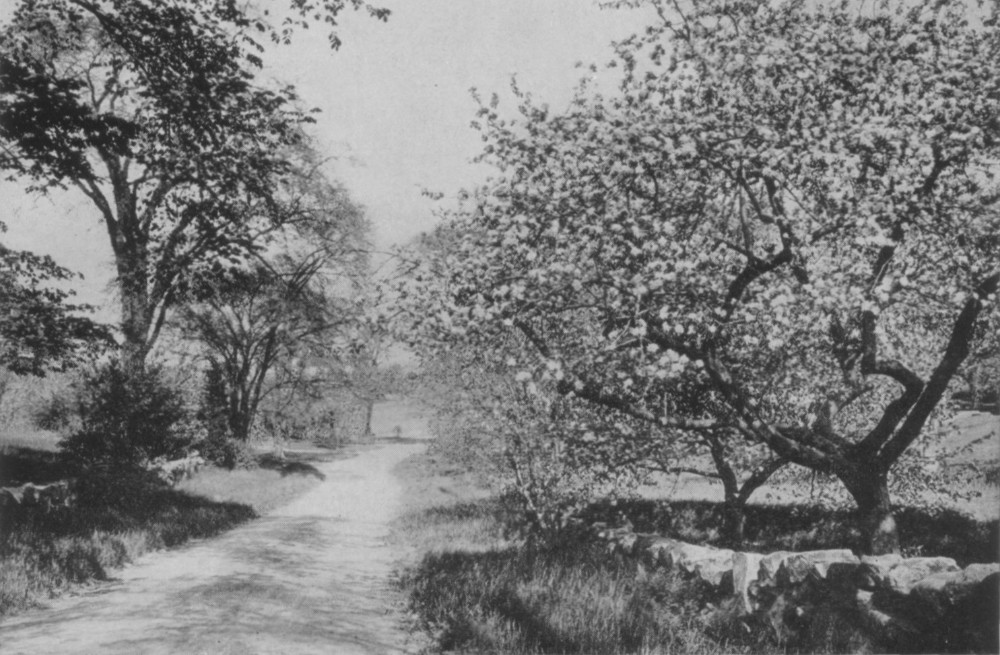 MAY ON THE TURNPIKE - MIDDLESEX 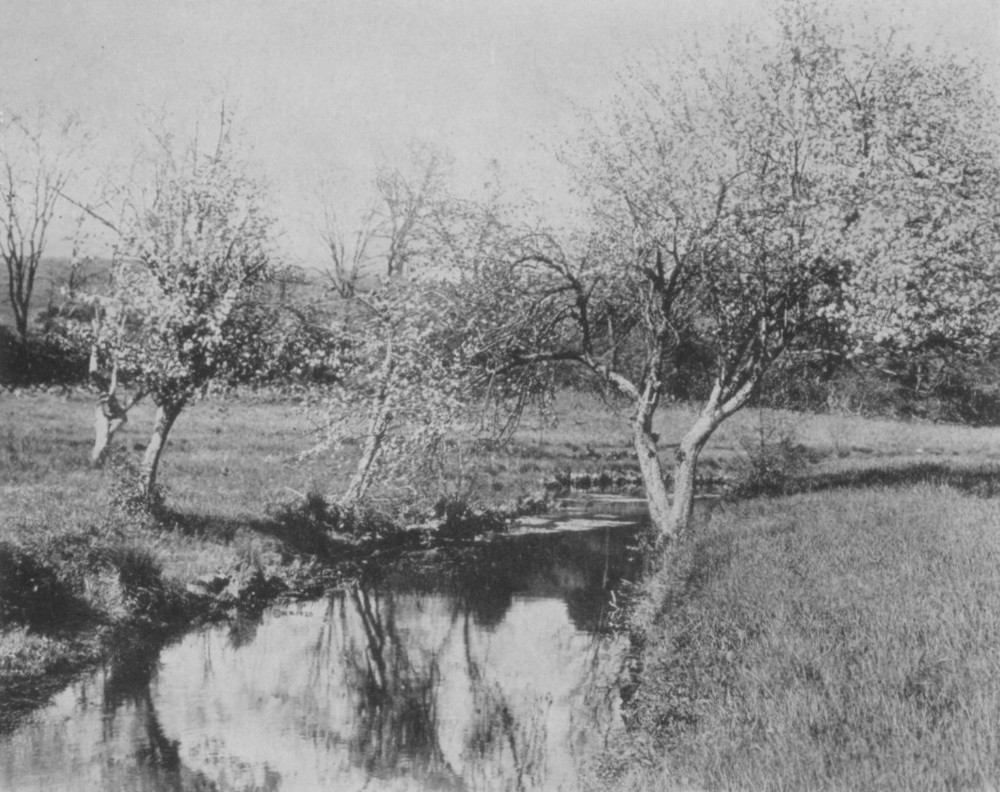 THE TIME OF JOY - SUDBURY 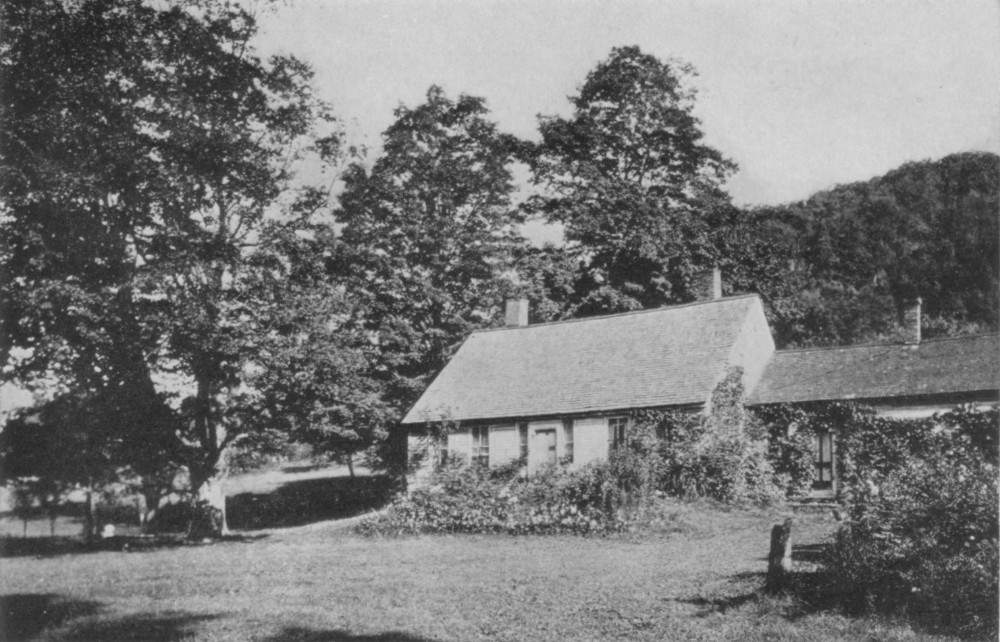 A CHARLEMONT COTTAGE - MOHAWK TRAIL 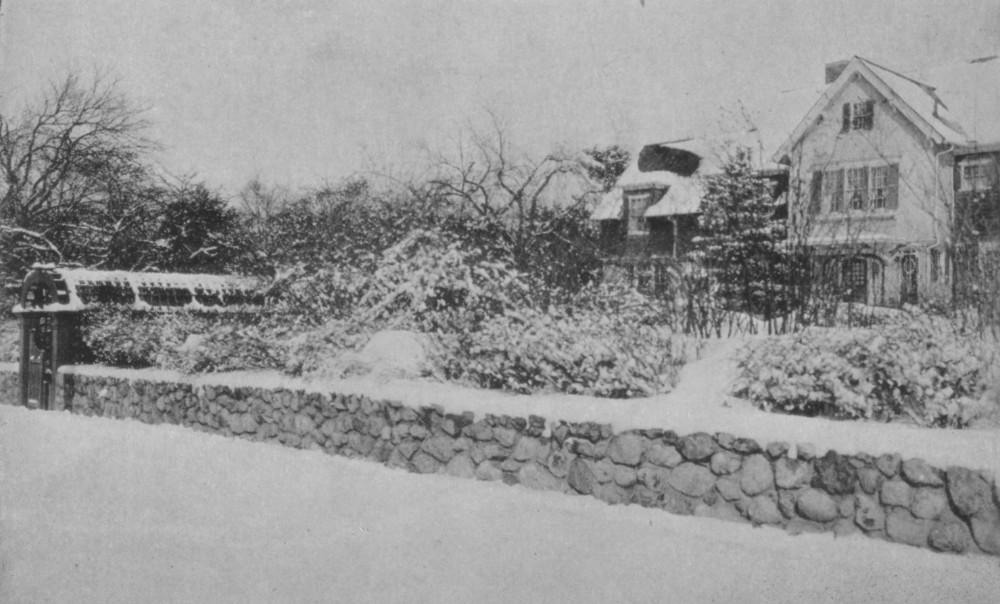 SNOW DECKED - DEDHAM A LITTLE PATH IN WESTON We were driving home one day and
looking into the west. Slowly there began to marshal themselves feathery bits
of cloud, rank on rank, in delicate color and general symmetry of form. They
rose in broad twin platoons, from a central point, until they covered a third
of the sky. We drew up by the roadside to see this demonstration of glory. It
was more marvelous than that of the burning bush which was not consumed. It
indicated a mind in nature that loved and fostered beauty. It formed from dust
and mist majestic archangels' wings. We said within ourselves that this
is ever the effort of mind in nature, to bring out beauty from a growing world.
It is a world where most remains yet to be done. It is a world, so far as
Massachusetts is concerned, with inspiring possibilities. Perhaps the important
thing for us to remember is that we are not working alone. There is, of course,
always, everywhere a protective power, a stimulating beauty, an effort at
revelation, an unfolding of glory in form and color. There is a new life, a
changing aspect, a better coming out of a good. There is a latent grandeur in
the rock-ribbed world. That we have come so far indicates a majestic and mighty
tide of intelligent purpose, to catch up into power and beauty the grasses, the
leaves, the stones and the very dust. Just to live, and feel this, is an
endless thrill of confidence and joy, and a call to get into step. It is a time of many laws. Inspirations are better than laws. A sense of the unity of nature, and a recognition of her glorious achievements, apart from us, is the beginning of education. Her best is good enough for this world, or any world, and her best with man's best, is a combination formed only in joy and the love of harmony. We shall find a better world as our eyes are opened. HIDDEN HOMES IF we understand the outline of the character of Adam which of course was inspired by the character of the narrator, a great deal of the joy which he got out of life was in having a plot of ground retired, personal and peculiar. On page 219 Cress Brook Road shows a little hidden domain in Norfolk county. It is withdrawn some quarter of a mile from the highway, and while the public is free to drive in on one side and out on the other, the road is practically private. It winds and rises and falls and passes an orchard, a meadow, a lake and a wood. The owner, some years since, found and developed the old homestead on a knoll, facing the water, and has a little domain hidden from the world. She will not be aware until she sees this sketch that the author has ever gleaned the charms of her drive. The marvel of such gleaning is that one leaves more behind him than he found, because when one looks upon and enjoys anything, and tells it, the location becomes more worthy in the eyes of those who follow. 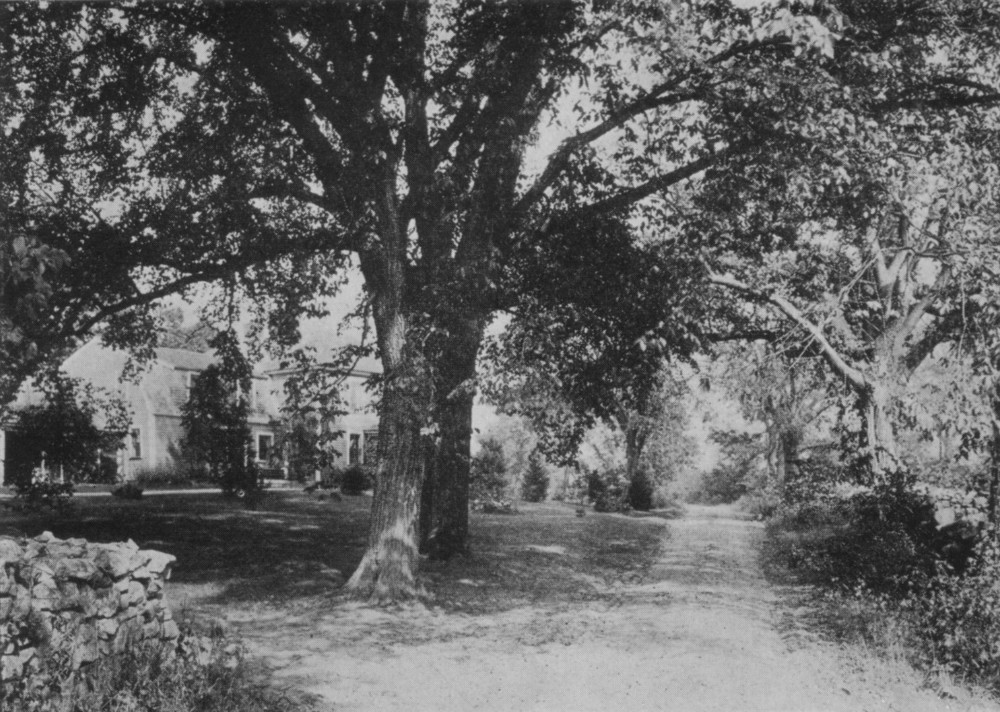 HOME ARCHES - HOLLISTON 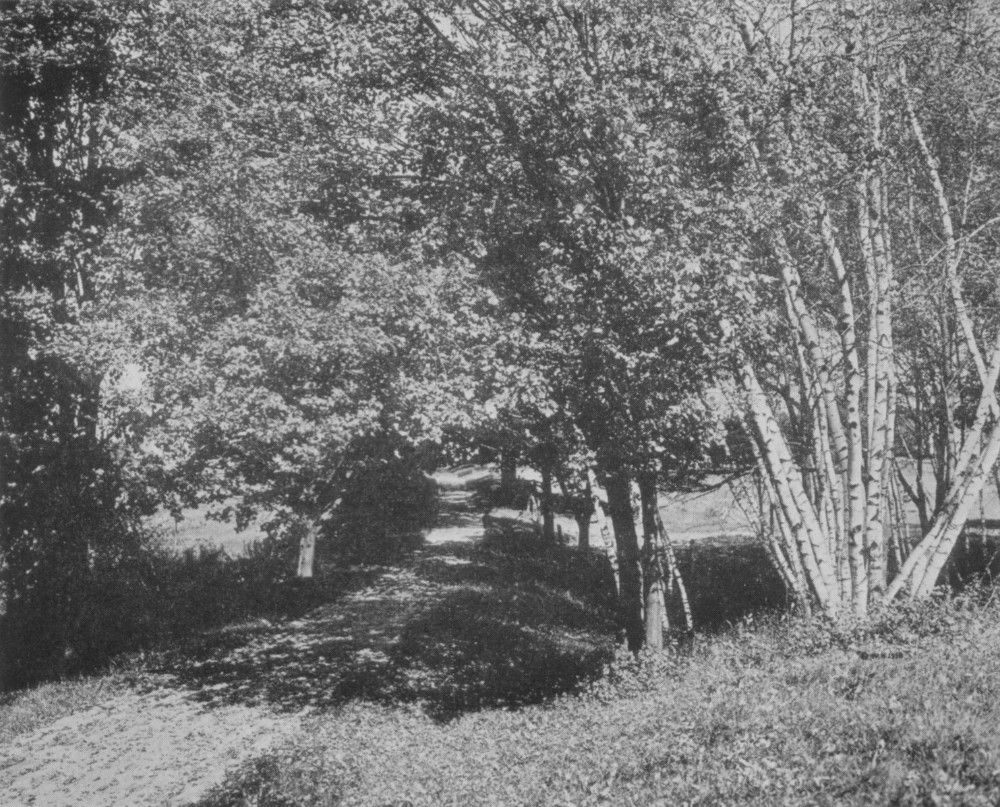 HOMEWARD BOUND - MILLIS-SHERBORN 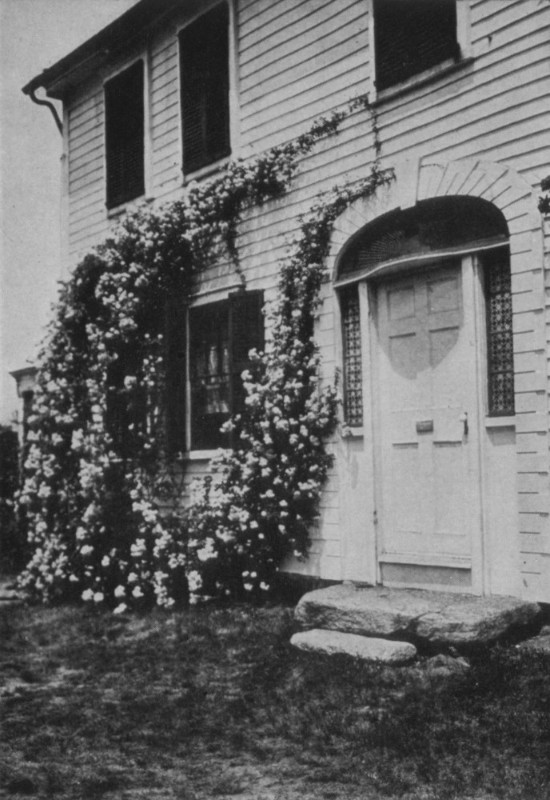 DOROTHY PERKINS 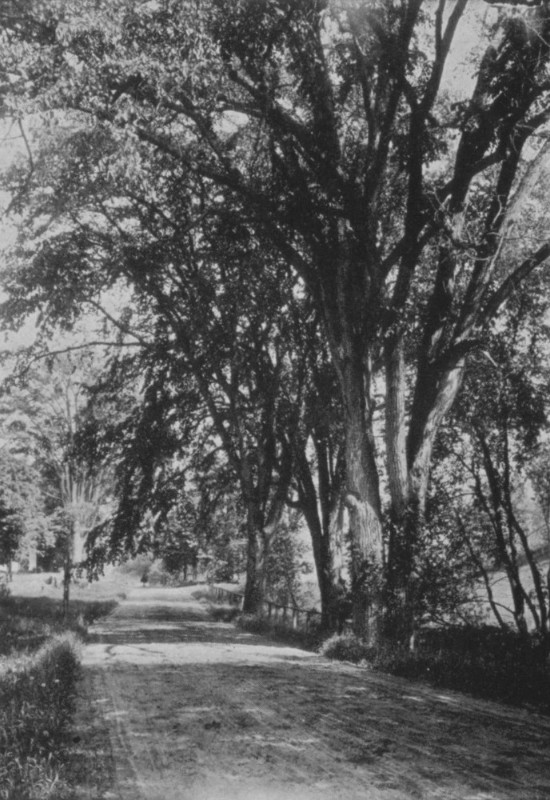 ELM SHADOWS Most of the great number of
pictorial records made by the author are still unknown to the residents nearest
the scenes concerned. Not a few are charming spots never so thought of or at
least thought of as purely local by the owners, but now made known broadly
through the country. There is in store for many, as the years go on, an
agreeable surprise, to find how much some nook or reach, familiar to the owner
has become loved by the general public. In the Cress Brook Road we have an example in which the views are all near, and the contour is wonderfully beautiful, though there is no distant prospect. It is a hiding place from the storms and the cares and the intrusions of the great world. It is our view that the main purpose of a home is the individual touch, and the charm of personal devotion to a few acres, by which the mind of the owner impresses itself on the landscape about him. It is an expression of his thought, in the curves of the walls, the foliage by the roadside, the grouping of the trees, secured by restraint or stimulus, and all the nameless marks of comfort or taste or enterprise, resulting from a mellow acquaintance with that particular section of God's earth. THE VARIETY OF ROOF OUTLINES WE have shown here and there the
remarkably large number of roof styles which were used, all of them within a
century, and all of them good. The so called monitor roof which rises in a kind
of clear story, is here and there found through the 18th century. The great
three story houses of the latter part of that century with their four chimneys,
did not slant the roofs as much as in the earlier part of the same century.
They secured a roomy dwelling but at the expense of picturesqueness and
weatherproof construction. We also have the gambrel of which Holmes wrote: "Gambrel, gambrel, let
me beg You'll look at a horse's hinder leg, First great angle above the roof, That's the gambrel, hence gambrel roof." We were slow to bring in this style and did not long continue to follow it. It is now being revised to a very great extent, and in certain sections of New England even the barns are constructed in this manner. Then, beginning with the pointed Gothic gable, which came in again in the Gothic revival of 1830, we proceed to the pavilion type, the so-called French roof type, and the broken roof, where various levels meet in picturesque confusion, and which belongs to no particular order of architecture. That style in which the second story window rises through the plate and becomes a kind of half dormer, so beautiful in England, when thatched, has been attempted here occasionally. Between the houses of wood, brick and stone arising out of our wealth of material, good American domestic architecture shows a wide and pleasing variety, nowhere better seen than in old Massachusetts. The roofs which slope four ways from a great central chimney, the roofs which have their pairs of chimneys at each end connected by a straight brick tie, the lean-to, the bow roof, the decked roof, and a great variety of combinations, exhibit an interesting record of tastes or needs. 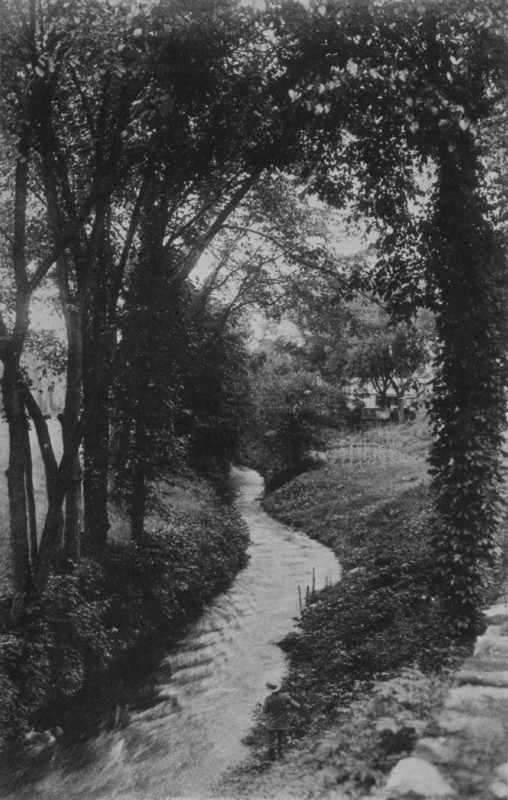 |
Web and Book design,
Copyright, Kellscraft Studio
1999-2008
(Return to Web Text-ures)
